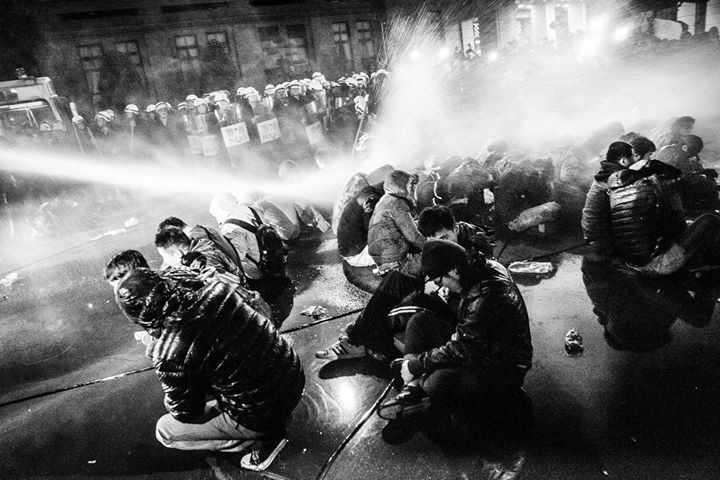Protesters stormed and occupied Taiwan's main legislature after the island's ruling party pushed a controversial trade bill with China through the Legislative Yuan without bipartisan discussion.
From March 18 to April 10, 2014 protesters occupied the Republic of China – Taiwan's Legislative Yuan. The demonstrations were branded as #CongressOccupied on Twitter and the Sunflower Movement; many protesters are holding sunflowers during their occupation and sit-ins.
On March 23, they expanded their occupation to the president's territory, the Executive Yuan, but protesters were soon violently removed by police. Several journalists and doctors were injured.
A week later, 500,000 people from all over Taiwan joined a public assembly in capital city Taipei to support the protesters.
Members of the movement left the country's legislature on April 10, 2014 after occupying the building for more than three weeks. Opinions are divided in Taiwan following the end of #CongressOccupied protests against a secretly negotiated trade deal with China.
Protesters conceded after the speaker of the Legislative Yuan, as the Taiwanese Congress is called, promised to pass legislation monitoring future agreements proposed by the executive branch before deliberating on the current Cross-Strait Service Trade Agreement (CSSTA). Some had worried the deal would make Taiwan vulnerable to political pressure from Beijing.
The controversial bill
Most lawmakers within the Legislative Yuan, agreed to review the agreement clause by clause. But on March 17, the chair of the legislature’s Internal Administrative Committee backed by the ruling party fast-tracked the agreement, skipping proper review processes. The bilateral trade agreement between Taiwan and China, the Cross-Strait Service Trade Agreement (CSSTA), was sent to Taiwan's congress for review on March 10, 2014 after 16 rounds of public hearings.
China-Taiwan trade
Since the Taiwanese and Chinese governments started signing bilateral economic cooperation agreements in 2010, a number of Taiwanese civic groups have been protesting against the “black-box” negotiation process not open to the public. Amid mounting pressure, the Legislative Yuan finally agreed to hold public hearings and a clause-by-clause review of the agreement, but the ruling party failed to keep that promise.
Taiwan and China have been governed separately for over 60 years, but China still treats the island as part of its territory. Taiwan's current President Ma Ying-jeou insists that increasing trade with China is essential to maintain Taiwan's economic competitiveness.
Even though China is a huge market for Taiwanese businesses, some fear the unrestricted entry of mainland capital poses a threat to Taiwanese culture, freedom of expression and even national security.
The bigger issue – one China
Legally, both governments of Taiwan and China claim to be “China” (Taiwan is technically ROC -Republic of China, and China is PRC – People's Republic of China) and neither recognize the other as a legitimate government.
The “one country” principle of the People’s Republic of China has been in constant conflict with the people of the Republic of China – Taiwan's wish to continue as an autonomous state. In 2005, the Anti-Secession Law was passed by China's National People’s Congress, stating that China will use non-peaceful means if Taiwan declares independence.
President Ma and China
The integration of Taiwan's economy with China was sped up by the Economic Cooperation Framework Agreement (ECFA) signed in June 2010. The CSSTA, which has triggered the occupation of Legislative Yuan protests, was signed in June 2013.
All these economic cooperation agreements were signed after President Ma assumed his office in 2008. In fact, President Ma and President Xi of the People's Republic of China are scheduled to meet at the Asia-Pacific Economic Cooperation meeting in Ningbo, China in May 2014 after the CSSTA has been endorsed in Taiwan. If it happens, the meeting between Xi and Ma will be a historical milestone. Leaders of the two ruling parties have not met each other since the Chinese Civil War in 1949. The May meeting has been interpreted as a resumption of cooperative relations between the two ruling parties.
Coverage
Apr 17 Would Confucius Support the Sunflower Movement in Taiwan?
Apr 5 #CongressOccupied Protesters Reject Taiwanese President's Proposed Solution
Apr 1 Designing Taiwan's #CongressOccupied Protests
Mar 31 Taiwan’s Indigenous Oppose Trade Deal With China
Mar 31 Half a Million Taiwanese Rally to Support #CongressOccupied
Mar 25 Taiwan's Heavy-handed Crackdown on #CongressOccupied Leaves Protesters, Journalists Injured
Mar 24 Dear #CongressOccupied Protesters, ‘Don't Let Taiwan Become the Next Hong Kong’
Mar 22 A Poem for #CongressOccupied Protesters in Taiwan
Mar 21 Taiwan's #CongressOccupied Protest, Translated
Mar 20 Support Pours in for #CongressOccupied Protesters in Taiwan
Mar 19 Protesters Occupy Taiwan's Legislature Over China Trade Deal
Jan 16 More Money, More Problems? Taiwan Opens Door to More Chinese Business

